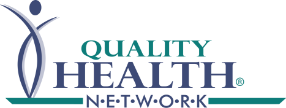“Alerts” are important and actionable electronic notifications triggered when patients are registered in the Emergency Department (ED) or are admitted to or discharged from a hospital. These real-time notifications provide information about a patient’s medical services encounter (which may include diagnosis and procedures), demographics, as well as the date and time of the event. The timely collection and distribution of these “alerts” to the various members of a patient’s community-wide and multi-disciplinary care team facilitates the needed follow up care required to improve the overall quality as well as lower the cost of care delivered to patients.
The difficulty in collecting and distributing these “alerts” is exacerbated by the fact that the area’s hospitals and providers are all using disparate electronic health record (EHR) systems. Quality Health Network (QHN), provides the connectivity and interoperability infrastructure required to collect and deliver alerts to care teams across western Colorado. In the 2nd quarter of 2016 almost 51,000 alerts were delivered to the more than 66 practices/organizations participating in this QHN service.
Providing a High Value Proposition
Alerts, and the utilization insights they disclose, have an increasing value proposition in the context of value-based payment models. While providers have always had a clinical interest in knowing about patient encounters and care outside of their practice or facility, new models are shifting financial incentives and risk to providers, making “patient panel intelligence” increasingly central to financial success.
Over the past several years, patient-centered medical homes (PCMHs) and accountable care organizations (ACOs) have focused on promoting enhanced collaboration between health care providers and rewarding high-quality, cost-efficient care. These models have gained recognition for their ability to improve care transitions, decrease inappropriate utilization and reform other aspects of the fragmented US healthcare system.
Alerts Support New Models of Care
“We were designated as a Patient Centered Medical Home (PCMH) in January of 2015. A big part of this designation is the communication between and among the patient’s providers,’” stated Robin Streaker, RN, Care Coordinator at Locke Family Medicine. “Just having the alerts as a resource to follow-up with the patient is huge. We are trying to be very proactive in our care coordination. I think it has really improved the quality of care we provide our patients.”
Telluride Medical Center’s Care Manager, Bridget Taddonio, employs alerts to improve the quality of patient care and help reduce inappropriate utilization of the healthcare system. “We had a family of seven that consistently used the Emergency Department at the hospital in a neighboring city, Montrose, CO, as their primary care for stomach bugs, sore throats and ear aches. These issues could have been easily dealt with in a primary care setting. I recognized this behavioral pattern of really high ED utilization. Using a translator at our facility, we were able to reach out to them and provide some basic education, help establish them with a PCP they are comfortable with, and gave them information on the urgent care locations in the area – they haven’t utilized the ED since!”
“The physicians love it. From the alert, I create for them a very compact, brief assessment of what happened and what medications were prescribed at discharge; it’s made it so much faster for them,” continued Taddonio. “I have found that the alerts eliminate any fragmentation of care.”
Dr. Jennifer Stroh, family Medicine, Grand Junction, CO reviews alerts sent to her from QHN via Direct. “I have an interface with QHN so much of the information already flows into my EHR, but I find patients that were in the ED and we never got an ED note. I generate a message in my EHR to my staff; we use this information for proactive care coordination. Alerts really help close that communication gap between the facilities and providers.”



